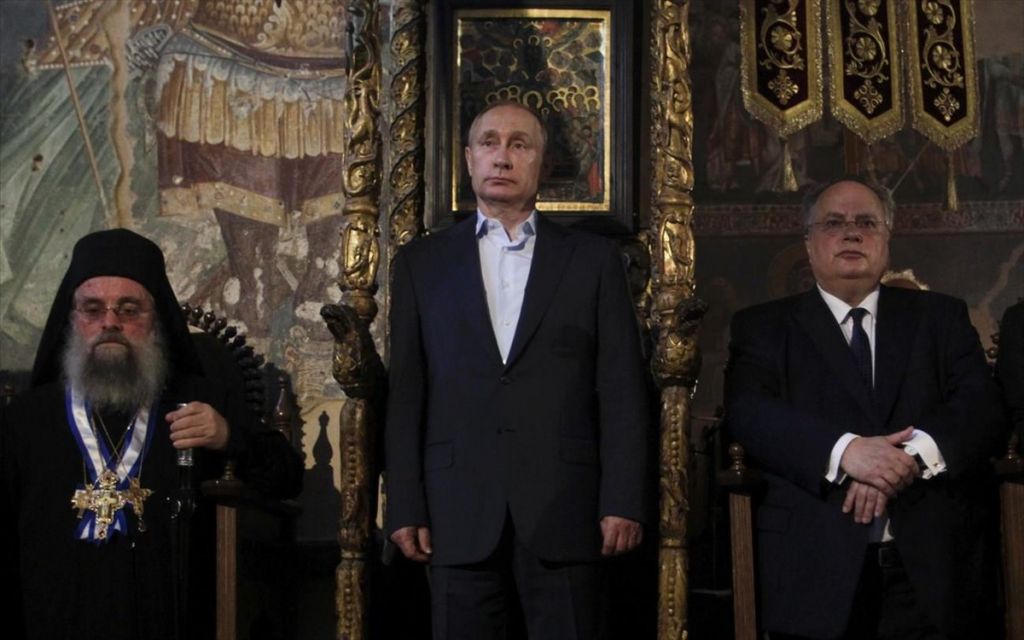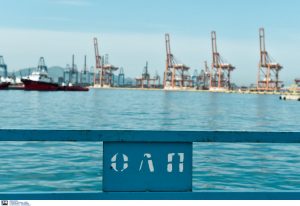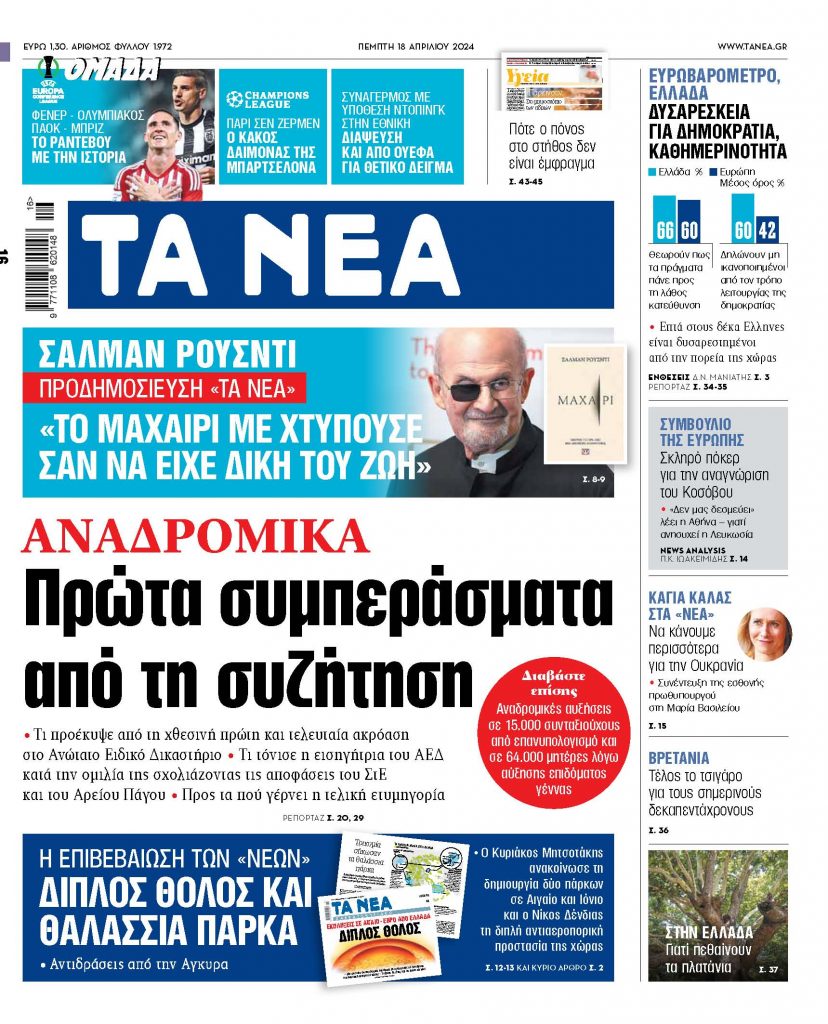By George Gilson
My first visits to the over 1,000-year-old monastic colony of Mount Athos were in the summers of 1981and 1982, when it was truly like traveling to Byzantium in a time capsule.
There was no electricity and pilgrims made their way to the obligatory pre-dawn services with gas lamps in churches lit only by oil lamps and candles, after a monk making the rounds of the courtyard had awakened everyone by rhythmically striking with a wooden mallet a very long, thick wooden plank carried on the shoulder call a “simantro”, a Byzantine organ used to call the faithful to services even before the introduction of church bells.
In the first two decades of the 21st century, however, huge amounts of EU National Strategic Reference Framework funding poured in for the much-needed restoration of the churches and buildings of the hundreds of years old monasteries (the oldest dates to the 10th century), but in all too many cases restorations turned into renovations, altering the character of buildings, dirt roads and cobblestone paths were widened and covered with cement, new unaesthetic buildings were erected, and monks in the capital of Karyes began using SUVs to carry pilgrims to monasteries.
The terrain and character of the place, alas, has become much more worldly, but the spiritual regimen remains much the same, and about 20,000 pilgrims and visitors from around the world visit each year to experience its unique sense of spiritual uplifting.
The Holy Mountain has always been viewed as the ark of the mystical spirituality of Eastern Orthodoxy, which its monks jealously guard with more than a touch of zealotry, with the large monasteries being custodians of a rich tradition, from their unique and magnificent Byzantine treasures, including the crowns and imperial costumes and decrees of emperors, granting them land and privileges, both within and outside the Athonite peninsula, to countless relics of saints and of the True Cross and Byzantine papyri.
Greek sovereign territory
The Athonite peninsula is Greek sovereign territory but enjoys autonomous rule with an executive sacred oversight body called the “Iera Epistasia”, comprised of one representative from each of the 20 main monasteries, presided over by the Protos, or first monk, who is selected by a rotational system in which they all participate.
On our first two journeys, we made the obligatory visit to the Russian Monastery of Saint Panteleimon, which stands apart from the others with its (completely different than the Byzantine style of other monasteries) magnificent Russian church architecture, the traditional onion domes, the enormous 13-tonne bell, and a plethora of opulent, precious jewel-studded objects and icons – the gifts of Tsars and Catherine the Great – and 35 chapels, with their iconostases (screens with icons mostly in the Western style that conceal the altar) covered with huge amounts of shiny gold leaf, in the Russian manner.
The Russian onslaught
What struck one most was the sheer size of the enormous buildings, as in the early 20th century Panteleimon Monastery housed thousands of monks and the brotherhood was continually growing until the 1917 Russian Revolution put an end to funding of the monastery, the population of which rapidly dwindled, putting an end to any expansionist geostrategic plans, which were revived after the fall of the Soviet Union, and particularly on Putin’s watch.
It was in the midst of the Cold War and one took with a grain of salt the whispers of Greek monks that there was an ample number of KGB agents among the monks of the brotherhood, a contention linked perhaps to Moscow’s agenda in the latter 19th and early 20th century history of the monastery.
Russia had flooded Athos with 3,000 monks at Saint Panteleimon but also other large monastic edifices, including the huge and magnificent Russian mid-19th century Skete of Saint Andrew (also known as the Sarai), which now belongs to Vatopedi Monastery, led by the Greek-Cypriot, Russophile and business-savvy Abbott Ephraim, who also enjoys a friendship with Prince Charles.
Packing Athos with Russian monks was central to a longstanding – and continuing – bid by Moscow to gain predominance in and control of the peninsula, as the Russian Empire had for centuries eyed the warm water ports that it lacked in Thessaloniki and in the Chalkidiki Peninsula. Athos’ main port is Dafni.
Today, that bid has been advanced by Pontic Greek-Russian businessman Ivan Savvidis, a friend and ally of Putin, who is a main partner in a consortium that has received the Port of Thessaloniki concession, and who also owns the huge, five-star Porto Carras tourist resort in Chalkidiki.
When after the Second Balkan War and the Treaty of Bucharest the representatives of the 20 Athonite monasteries passed a resolution, presented to King Constantine I of Greece, that the monastic colony would retain its administrative autonomy and that the peninsula would be Greek sovereign territory, only the representative of the Russian monastery voted it down.
Putin’s war, Russian influence in Greece, on Athos
Long before his 24 February invasion of Ukraine, Vladimir Putin’s in his two decades in power has made enormous headway in his bid to expand Russian influence in Greece, and in this effort the Moscow Patriarchate – which functions essentially as the long arm of the Kremlin, wielding enormous geopolitical soft power in Orthodox countries through skillful use of its vast wealth – under Patriarch Kyrill has vastly increased its influence both among a number of Metropolitan bishops of the Church of Greece and, especially, on Mount Athos.
Expulsions of Russian diplomats
The Greek government has twice expelled a number of Russian diplomats, and in both cases their activity vis a vis Mount Athos was said to be a factor in the decisions.
In July, 2018, the left-wing SYRIZA government expelled two Russian diplomats and barred entry into Greece of two others, amidst heightened efforts by Moscow to expand its influence in Greece and to scuttle Athens’ efforts to conclude the Prespa Agreement, which after over two decades resolved the Macedonian naming issue and opened the way for the newly renamed North Macedonia to be admitted to NATO, which Moscow vehemently opposed and feverishly worked to undermine.
Most recently, on 6 April, in the shadow of the Russian invasion of Ukraine, and in line with the actions of a number of other EU countries that expelled 200 Russian diplomats, the current Greek government decided, after an 18-month investigation, to expel 12 Russian diplomats (serving at the embassy in Athens and consulates), initially declaring them personae non gratae. Moscow is believed, inter alia, to have lent strong support to the anti-vaxxers’ movement in Greece.
Panteleimon Monastery: the jewel in the crown
Over the last two decades, Moscow has invested heavily in rebuilding and expanding the Russian Saint Panteleimon Monastery, including the establishment of a 2,000 square metre museum inaugurated in 2006 by Moscow Patriarch Kyrill, for whom the monastery is an important outpost.
Panteleimon has some 65 monks, and while the majority of the brotherhood is of Ukrainian descent, the Abbott is Russian. The monastery’s representative in Athos’ capital of Karyes is Ukrainian.
A source speaking on background from the civil authority of Mount Athos, which has a Greek civil governor, says that relations between Ukrainian and Russian Panteleimon Monastery monks are harmonious, though it is probably too early to say how the horrors of the war in Ukraine will impact on the brotherhood, and possible tensions are conceivably being swept under the rug for now.
Putin’s presence
Putin has made the strong Russia presence on Mount Athos glaringly obvious with his repeated visits to the Holy Mountain – including those in September, 2005 (the first visit of a foreign head of state to Athos) and in May, 2016.
Putin’s 2016 visit caused a diplomatic incident involving then Greek President Prokopis Pavlopoulos, who travelled to the Holy Mountain to welcome his Russian counterpart and, with his presence, to indirectly underscore that Athos is Greek sovereign territory.
In the customary doxology (Te Deum) held at the monastic colony’s cathedral of the Protato when high-level dignitaries visit, the Athonite monks decided that Putin, with imperial pomp and ceremony as the “honoured person”, would stand on the throne of the Ecumenical Patriarch – who has spiritual authority over Athos and is its bishop and against whom Putin later unleashed vitriolic attacks accusing him of being bought off by the Americans to grant the Ukrainian Church Autocephaly, or independence, from the Moscow Patriarchate in December, 2018, following years of persistent demands from the flock – and not the Greek President, who decided to wait outside and receive Putin after the service rather than bear the insult of being seated at a lower level.
Mount Athos’ governing body, the Iera Epistasia, which took the decision, rejected a compromise proposal that two armchairs be placed side-by-side at the same level.
That move was widely viewed as an indication of Moscow’s strong influence with powerful Athonite Abbotts.
One of the most prominent, Abbott Ephraim of the extremely wealthy Vatopedi Monastery, has over the years developed an apparently cordial relationship with Putin.
In November, 2011, just four months before the 4 March, 2012 Russian presidential election, in which Putin returned to power as head of state, succeeding Dmitry Medvedev, Ephraim agreed to bring to Russia the monastery’s most sacred relic, a strip of cloth traditionally believed to be a part of the girdle of the Panaghia (Virgin Mary).
Ephraim took the relic on a 30-day tour of major Russian cities, with thousands flocking to venerate and make lucrative donations, and the tour ended at the huge Cathedral Church of the Saviour in Moscow, where Ephraim, standing beside Medvedev’s wife, reportedly handed her prayer beads, which she proceeded to wear around her wrist.
A number of Russian oligarchs reportedly have visited Mount Athos repeatedly in a display of piety, though it is unclear if and to what extent they may have made donations to monasteries.
Closer, coordinated monitoring by Greek Police, EYP
Following its decision to expel the Russian diplomats, the Greek government proceeded with a radical shake-up of policing and security on Mount Athos.
According to a high-level source in the civil governor’s office, about two weeks ago, at the request of the Athonite monks, Mount Athos’ police precinct, and the peninsula’s Fire Brigade and Coast Guard contingents, were placed under the direct supervision of the Chief of Greek Police (ELAS) in Athens, and under the immediate oversight of the ELAS’s General Inspector of Police for Northern Greece, based in Thessaloniki.
Until now, the Athos police precinct was under the purview of the small police precinct of Polygyros, Chalkidiki, 65km from the port of Ouranopolis, from which pilgrims travel to Mount Athos by boat.
That, effectively, meant that there was minimal police supervision of various often suspect activities on Mount Athos.
According to an exclusive, 23 April report in To Vima by veteran police correspondent Vasilis Labropoulos, a new, upgraded corps of 70 uniformed and undercover policemen assigned to police the Holy Mountain will be based in Thessaloniki.
The plan, the report indicates, involves “careful screening of those entering and leaving Mount Athos so as to avert the prospect of individuals – exploiting the sacredness of the area, the stance of monks, and the absence of substantial policing – transporting weapons, drugs, and other illegal objects, or engaging in other suspect activity, particularly in the midst of the continuing crisis between Greece (and the West more generally) and Russia”.
The report says that visitors’ “possible links to political divs or the pursuits of other countries” will be scrutinised, “given recent and older reports of specific monasteries being implicated in geopolitical games and the exertion of influence”.
“The role of particular individuals in ‘money laundering’ on behalf of international crime rings” will be probed based on information already collected by authorities, according to To Vima.
Counter-espionage
The new policing and security structure appears to have a distinct counter-espionage component.
“EYP (Greece’s National Intelligence Service) will conduct analyses of data collected in conjunction with other information. It appears that intelligence services had such evidence at their disposal in 2018, when the expulsion of Russian diplomats who engaged in intensive activities in the area was decided,” the report underlined.
“ELAS officials note that until now authorities had a ‘blurry’ picture of activities undertaken with utter secrecy on the Athonite peninsula, which has an area of about 336 square kilometres,” To Vima’s report concludes.


